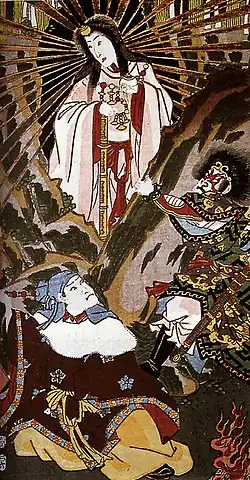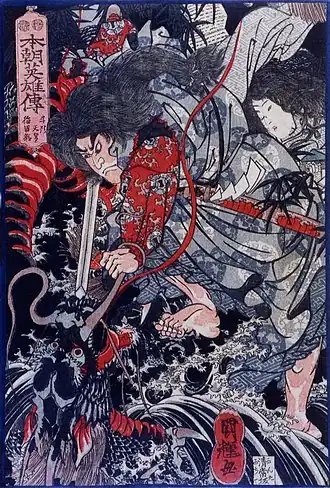Tenson kōrin
In Japanese mythology, the tenson kōrin (天孫降臨) is the descent of Amaterasu's grandson Ninigi-no-Mikoto from Heaven (Takamagahara) to Ashihara no Nakatsukuni; according to legend, the direct place of descent is at Takachiho-gawara in Japan.[1][2] Following the tenson kōrin, Ninigi's son, Hoori, was born.
Three generations of Hyuga
After the Tenson Korin there were the Three Generations of Hyuga until Jimmu's Eastern Expedition when the Imperial House of Japan was founded.[3]
- Red background is female.
- Green background means groups
- Bold letters are three generations of Hyuga.
Alternate tellings
In some versions of this story, more gods came down from heaven besides Ninigi-no-Mikoto.[11]
References
- ^ Guide, Japan Hoppers Travel. "Takachiho-gawara | Kirishima | Japan Travel Guide - Japan Hoppers". Japan Hoppers - Free Japan Travel Guide. Retrieved 2019-02-05.
- ^ Chilson, Clark; Swanson, Paul, eds. (2006). Nanzan Guide to Japanese Religions. University of Hawaii Press. p. 131. ISBN 978-0-8248-3002-1.
- ^ "みやざきの神話と伝承101:概説". 2021-08-04. Archived from the original on 4 August 2021. Retrieved 2022-06-12.
- ^ a b c Borgen, Robert; Ury, Marian (April 1990). "Readable Japanese Mythology: Selections from Nihon shoki and Kojiki" (PDF). The Journal of the Association of Teachers of Japanese. 24 (1). American Association of Teachers of Japanese: 61–97. doi:10.2307/489230. JSTOR 489230. Retrieved 12 April 2020.
- ^ a b https://archive.today/20230406174104/https://d-museum.kokugakuin.ac.jp/eos/detail/?id=9716
- ^ a b c d e Nihongi: Chronicles of Japan from the Earliest Times to A.D. 697, translated from the original Chinese and Japanese by William George Aston. Book II, page 73. Tuttle Publishing. Tra edition (July 2005). First edition published 1972. ISBN 978-0-8048-3674-6
- ^ a b c Akima, Toshio (1993). "The Origins of the Grand Shrine of Ise and the Cult of the Sun Goddess Amaterasu Ōmikami". Japan Review. 4 (4): 143. ISSN 0915-0986. JSTOR 25790929.
- ^ a b c Tsugita, Masaki (2001) [1977]. 古事記 (上) 全訳注 [Complete Translated and Annotated Kojiki, Part 1]. Vol. 38. 講談社学術文庫. p. 205. ISBN 4-06-158207-0.
- ^ a b c d e The History of Nations: Japan. Dept. of education. Japan. H. W. Snow. 1910.
- ^ The Kojiki: Records of Ancient Matters. Tuttle Publishing. 19 June 2012. p. 218. ISBN 978-1-4629-0511-9.
- ^ Sonoda, Minoru [in Japanese]; Mogi, Sakae (1997). Nihon no kamigami no jiten : Shinto saishi to yaoyorozu no kamigami (in Japanese). Gakken. pp. 68, 69. ISBN 9784056016291. OCLC 42978057.

